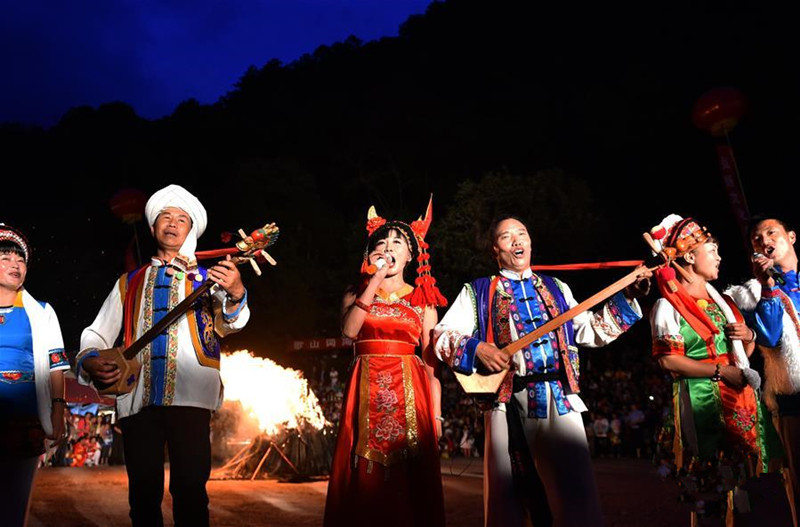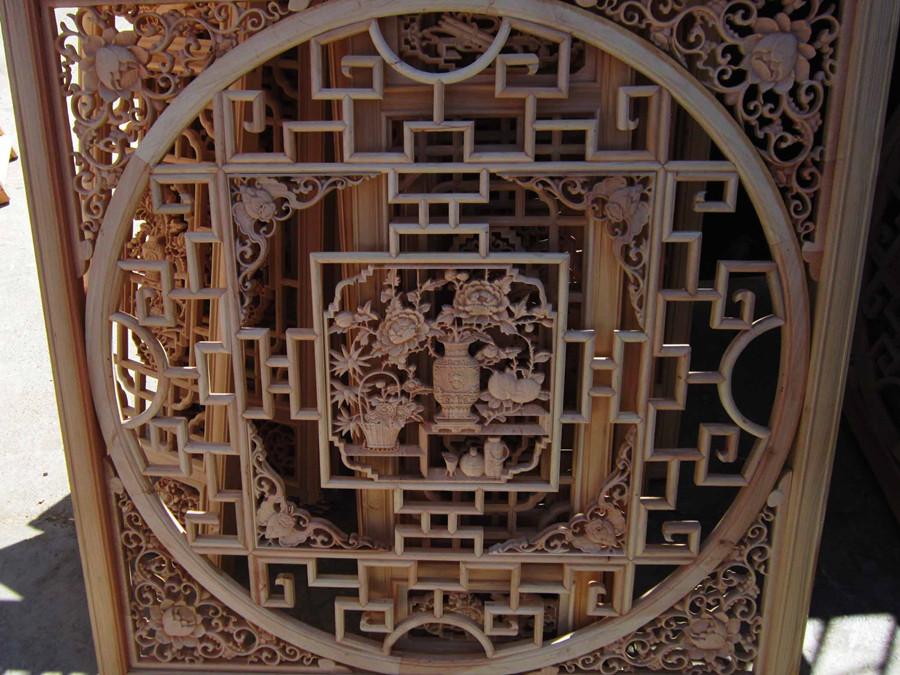
Bai Ethnic Minority
Bai ethnic minority is introduced from the history, cultural heritages and ethnic festivals. Bai ethnic group is the 15th largest ethnic group in China, mainly distributed in Yunnan, Guizhou, Hunan and other provinces, among them, Bai minority in Yunnan province has the largest population, mainly living in Dali Bai autonomous prefecture. Bai minority has its own ethnic language, which belongs to the Tibetan-Myanmese roup of the Chinese-Tibetan language family. The Chinese character has been used by the Bai people since ancient times.
Features of Bai Area in Yunnan
Situated on the Yunnan-Guizhou Plateau, the Bai area is crisscrossed with rivers, of which the major ones are the Lancang, the Nujiang and the Jinsha. The river valleys, dense forests and vast tracts of land form a beautiful landscape and provide an abundance of crops and fruits. The Bai area around Erhai lake in Dali Bai autonomous prefecture is blessed with a mild climate and fertile land yielding two crops a year. Here, the main crops are rice, winter wheat, beans, millet, cotton, rape, sugar-cane and tobacco. The forests have valuable stocks of timber, herbs of medicinal value and rare animals. Cangshan Mountain beside Lake Erhai contains a rich deposit of the famous Yunnan marble, which is basically pure white with veins of red, light blue, green and milky yellow. It is treasured as building material as well as for carving.
History of Bai Ethnic Minority
The origin of Bai has the characteristics of diversity. The earliest ancestors of Bai are formed by fusion of indigenious Kunming people and Heman people(河蛮人) by Erhai Lake, as well as Di people(氐人) and Qiang people(羌人) from Qinghai-Tibet plateau, and then infusing Sou people(叟人), Ailao people, Dian people(滇人), Han people and other ethnic groups. In thousands of years of history, due to the war, expansion, trade, station troops and other historical reasons, Bai people gradually formed the embryonic form of the current Bai minority. After the Yuan dynasty, people whose cultural attributes were more similar to those of the Han nationality were identified as an ethnic group and called “Bai people(白人)”. “Bai people” is the earliest unified race of Bai ancestors. They are called “Minjia” after Ming and Qing dynasties. After the founding of the People’s Republic of China, in November 1956, according to the will of the majority of the Bai people, the Bai minority was officially defined as the unified name.
Distribution of Bai Minority
Bai ethnic minority is mainly distributed in Dali Bai Autonomous Prefecture of Yunnan province. Dali is the origin, ancestral home and main settlement of the Bai minority, about 80% of Bai inhabit here. In addition, Kunming, Lijiang, Nujiang, Diqing, Baoshan, Yuxi, Chuxiong, Wenshan, Lincang and other places have Bai minority as well. Zhangjiajie and Xiangxi of Hunan, Bijie and Anshun of Guizhou, Liangshan of Sichuan also have the distribution of Bai minority.
Bai Ethnic Townships
Jinjiang Bai Ethnic Town Shitou Bai Ethnic Town Jinshan Bai Ethnic Town Jiuhe Bai Ethnic Town Potou Yi, Miao and Bai Ethnic Town Shalang Bai Ethnic Town Gulv Yi and Bai Ethnic Town Yangliu Yi and Bai Ethnic Town Wama Yi and Bai Ethnic Town Guodazhai Yi and Bai Ethnic Town Yulu Bai Ethnic Town Laowo Bai Ethnic Town Luobenzhuo Bai Ethnic Town
Cultural Heritages of Bai Ethnic Minority
Bai minority is unique in art, its architecture, sculpture and painting art enjoys a high reputation. In the process of formation and development, with the surrounding ethnic mutual exchanges, Bai people created a brilliant economic culture. The Bai minority is divided into three branches, namely Minjia, Lemo and Nama, and they are deeply influenced by Han culture.
Gilding Craft Erzi Ge Folk Dance Chuichui Qiang Drama Meiyuan Village Stone Sculpture House Painting Bai Opera Genital Worship Ligegao Dance Ornamented Civilian Architecture
Inheritors
Bai Tie Yang Tianrui Cun Fabiao Yang Kewen Duan Yinkai Zhang Jiexing Luo Jiajing Duan Dekun Yi Dequan Zhao Guangzong Zhang Yueqiu Zhang Qingchang Zhao Pengyun Li Baomei Duan Qingfeng Huang Sidai Yang Huiying Duan Wenxin Mu Binglin Zhang Wenxian Duan Zhenran Dong Zhonghao Li Yuansheng A Cainiu Zhang Sujuan Liu Lihu Liang Xiaolong Zhang Wenxiang Yang Ruichen Xu Guozhen Nie Yuanlong Yang Shichang Li Xincheng Chen Yongxian Li Yunxin Liu Pei Zhang Dehe Li Yunyi Zhao Piding Zhao Piding Zhao Qi Yu Ao Zhang Shishen
Protection Area
Zhoucheng Bai Ethnic Culture Protection Area Dayingzhen Village Bai Ethnic Culture Protection Area
Festivals and Activities of Bai Ethnic Minority
Lantern Festival Taiping Festival Gndenghui Festival Dragon Boat Race Festival Jianhu Lake Encircling Festival Caishen Temple Fair Xiaojizu Singing Festival Guanyin Temple Fiar Flower Festival (Huazhaojie) Jiejingu Festival Tianzi Temple Fair Benzhu Worship Festival Benzhu Worship and Knife-ladder-climbing Festival Binchuan Grape Cultural Tourism Festival Danglu Festival Confucius Memorial Ceremony Tianchi Lake Pear Blossom Festival Qingyuan Cave Singing Festival Jiuqitai Outdoor Hot Spring Bath Festival Transplanting Rice Competition Naochunwang Festival Haideng Lantern Festival Prince Festival Buddha Birthday Festival Laba Festival Nirvana Festival Maitreya Assembly Yulanpen Festival Guozi Festival Shuahai Festival April 8th(Siyueba) Festival Kaihai Festival (Kaihaijie) Qingguniang Festival Mule and Horse Trade Fair Pueraria Montana(Gegenhui) Festival Shuahaihui Festival Pear Blossom Festival Jizu Mountain Pilgrimage Festival Haixihai Folk Song Festival Cibihu Folk Song Festival Shibaoshan Folk Song Festival Worship of the Communal Gods Dongyuegong Temple Fair Bathing Festival Butterfly Festival Taizi Temple Fair March Street (Sanyuejie) Festival Dali International Orchid and Camellia Fair
Keep Reading
Wood-carving Craft Protection in Xingyi Classic Woodcarving Furniture Factory Mazhelong Village of Longying Town in Qiubei County Qingshan Village of Shuanglang Town Jinhe Village of Xizhou Town in Dali Milk Fan and Three Cups of Tea of Bai Ethnic Minority Wearing White Costumes of Bai Ethnic Minority Bai Ethnic Minority Residing Near the Blue Mountain and the Erhai Lake

 7 Days GolfingTour
7 Days GolfingTour
 8 Days Group Tour
8 Days Group Tour
 8 Days Yunnan Tour
8 Days Yunnan Tour
 7 Days Shangri La Hiking
7 Days Shangri La Hiking
 11 Days Yunnan Tour
11 Days Yunnan Tour
 6 Days Yuanyang Terraces
6 Days Yuanyang Terraces
 11 Days Yunnan Tour
11 Days Yunnan Tour
 8 Days South Yunnan
8 Days South Yunnan
 7 Days Tea Tour
7 Days Tea Tour
 8 Days Muslim Tour
8 Days Muslim Tour
 12 Days Self-Driving
12 Days Self-Driving
 4 Days Haba Climbing
4 Days Haba Climbing
 Tiger Leaping Gorge
Tiger Leaping Gorge
 Stone Forest
Stone Forest
 Yunnan-Tibet
Yunnan-Tibet
 Hani Rice Terraces
Hani Rice Terraces
 Kunming
Kunming
 Lijiang
Lijiang
 Shangri-la
Shangri-la
 Dali
Dali
 XishuangBanna
XishuangBanna
 Honghe
Honghe
 Kunming
Kunming
 Lijiang
Lijiang
 Shangri-la
Shangri-la
 Yuanyang Rice Terraces
Yuanyang Rice Terraces
 Nujiang
Nujiang
 XishuangBanna
XishuangBanna
 Spring City Golf
Spring City Golf
 Snow Mountain Golf
Snow Mountain Golf
 Stone Mountain Golf
Stone Mountain Golf















